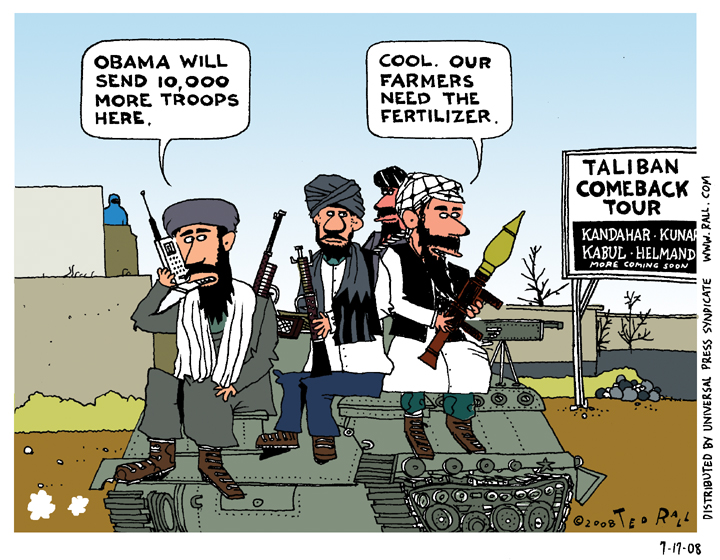Excuses Ring Hollow in U.S.-Occupied Afghanistan
Staff Sargeant Robert Bales is the man accused of going on a March 11th shooting spree that left 16 civilians dead in southeastern Afghanistan. As the New York Daily News put it: “The killings sparked protests in Afghanistan, endangered relations between the two countries and threatened to upend American policy over the decade-old war.”
Why the fuss? This is nothing new. Not to the Afghans.
Over the last ten years U.S. forces have been slaughtering Afghan civilians like they were going out of style. There have been countless massacres of supposed “insurgents” or “terrorists.” Who invariably turned out to have been ordinary men, women and children going about their daily routines.
The only difference between the Bales massacre and other acts of bloodshed is that he acted on a freelance basis, minus orders from his commanding officer. Bales’ actions were so similar to the “normal” behavior of U.S. soldiers that Afghan witnesses weren’t surprised.
Atrocities are business as usual. Afghans have learned that their lives are cheap–not to them, but to the young men and women who patrol their streets and man explosives-laden drone planes from the other side of the world.
On July 7th, for example, an airstrike in Khost province killed at least 13 civilians, mostly women and children. On December 19th, U.S. occupation troops and Afghan collaborators conducting a “night raid” on the home of an anti-narcotics official in Paktia province shot and killed his pregnant wife. At least eight children died in a February 9th airstrike in Kapisa province. A helicopter gunship opened fire on a school in Nangahar province on February 22nd, injuring nine girls.
I literally don’t have enough space to provide a complete accounting of recent U.S. atrocities in occupied Afghanistan. Here’s a brief taste: U.S. Special Forces operatives alone admit killing over 1,500 Afghan civilians in night raids alone during 10 months in 2010 and early 2011.
Afghans know the deal.
Americans don’t.
It’s intentional. The U.S. government doesn’t want ordinary American citizens to know how their “heroic” soldiers behave in remote combat zones. America’s cult of militarism, so important to the Congressmen whose careers depend on defense contractor contributors and to the media outlets for whom war means higher ratings, requires a placid, compliant populace lulled into the ridiculous belief that the U.S. military is defending freedom.
Sgt. Bales is a PR problem. His decision to blow away women and children for no reason whatsoever belies the hero-troops narrative. It’s too icky for even a “support our troops”-besotted public to ignore. So Sgt. Bales has become a political football.
Shortly after the suspect turned himself in, the Army spin machine revved up.
“When it all comes out, it will be a combination of stress, alcohol and domestic issues–he just snapped,” an unnamed “senior government official” told The New York Times. Just one of those things. What can you do?
Pointing to the fact that Bales’ spree took place while he was on his fourth tour of duty, his lawyer is laying the groundwork for a PTSD defense. “We all know what’s going on over there [in Afghanistan], but you don’t really know it until you listen to somebody like him,” John Henry Browne said to reporters. In other words: war makes people nuts. Blame war, not my client.
After incidents like this, one can always count upon the political class to unleash the “one bad apple” chestnut.
“This incident is tragic and shocking, and does not represent the exceptional character of our military and the respect that the United States has for the people of Afghanistan,” President Obama read from a prepared statement. “Obviously what happened this weekend was absolutely tragic and heartbreaking, but when you look at what hundreds of thousands of our military personnel have, have achieved under enormous strain, you can’t help but be proud generally and I think it’s important for us to make sure we are not in Afghanistan longer than we need to be,” he added in a Denver TV interview.
Don’t blame the war, says Obama. Don’t blame the troops. Whether they’re shooting up their high school or their post office, some people go nuts sometimes. Can’t be helped.
Of course, from the Afghan point of view, this is low-grade, elementary-school-level spin.
Afghans don’t wonder whether the former All-American footballer from Norwood, Ohio was driven crazy by combat, was like that all along, or if this is another Jessica Lynch/Pat Tillman Pentagon lie that will wind up as something completely different than what we’re being told now.
Afghans don’t care why.
The way the Afghans see it is straightforward. The U.S. invaded their country. Without just cause. The U.S. has imposed a ruthless and cruel occupation that has left tens of thousands of their countrymen dead or seriously wounded. The U.S. has installed and propped up Hamid Karzai’s corrupt puppet regime in Kabul.
To the Afghans, Sgt. Bales didn’t kill those 16 people in Kandahar province. The U.S. did. Obama did. We did. After all, if we hadn’t invaded and occupied Afghanistan, Bales wouldn’t have been there in the first place.
Reporters are digging up dirt on Sgt. Bales’ marriage and supposed drinking problems in order to distract us from this simple fact.
(Ted Rall’s next book is “The Book of Obama: How We Went From Hope and Change to the Age of Revolt,” out May 22. His website is tedrall.com.)

